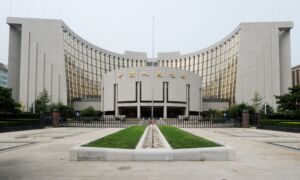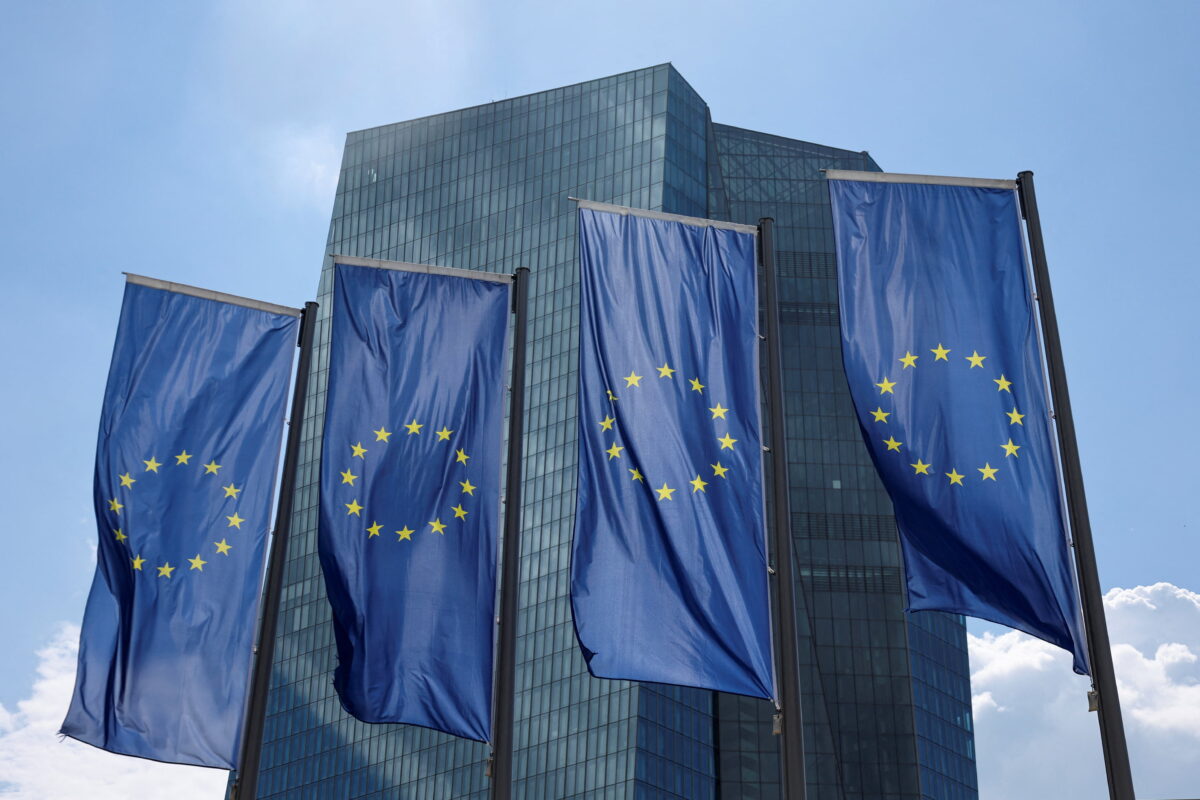East and West Diverge on Monetary Policy
CommentaryInflation has forced Western central banks to raise interest rates, but in Asia, China has taken the opposite tack. All the central bankers—East and West—worry over a recession. Still, the lessons of the last great inflation of the 1970s and 1980s have convinced the Federal Reserve (Fed), the European Central Bank (ECB), and other Western bankers that they have little choice but to move toward monetary restraint. China, however, faces a very different set of pressures. Confronted by much less intense inflationary pressure than the West and highly concerned about the nation’s poor economic prospects, the People’s Bank of China (PBOC) has cut interest rates, albeit only marginally, and otherwise eased monetary policy. In the West, the Fed has made a major commitment. Since March, when the Fed finally awoke to the inflationary threat facing the nation, policymakers have raised the federal funds interest rate target from 1.5 percentage points to a level of 2.25-2.5 percent. The Fed’s Open Market Committee (FOMC) is expected to add another 0.75 percentage points to the target rate when it meets later this month. The Bank of Canada has, if anything, surpassed the Fed. Since March, it has raised its target overnight lending rate five times for a total of 3 percentage points. These rates are higher now than at any time in the last 14 years. More recently, the ECB has joined this trend. Reluctant to raise interest rates earlier in the year for fear of a recession, European policymakers have at last acknowledged the need for monetary restraint, raising their target short-term interest rate some 0.75 percentage points. Although their target of about 1.25 percent remains well below American rates, ECB policymakers have promised further hikes along these lines to catch up with their cousins in North America. The ECB had to overcome a lot of concerns to step up to this new policy. Unlike North America, the economies in its jurisdiction are nowhere near full employment, and with energy shortages threatening, the prospect of economic decline is much more real than on this side of the Atlantic. But the growing interest rate differential had attracted money from Europe to America so that the euro fell 15 percent against the dollar, and policymakers could see an added inflationary potential in that move. They were also well aware that had they failed to take action against inflation, businesses and individuals would come to expect it and thereby make it ultimately harder to gain control. European flags are seen in front of the European Central Bank (ECB) building in Frankfurt, Germany, on July 21, 2022. (Wolfgang Rattay/Reuters) China has had to steer a very different course. In one respect, its bankers are under a lot less pressure to act than the Western economies. Its inflation, to be sure, has risen—from 0.9 percent last February to 2.7 percent in July, the most recent period for which data are available. Despite the rise, this is a lot less frightening than the 8-9 percent rates of inflation in the West. Besides, it is not much above the 2.3 percent a year averaged by Chinese inflation over the last 20 years and is still below Beijing’s official 3.0 percent ceiling. More telling to policymakers, however, are the real economic impediments facing China. The lockdowns and quarantines used to combat COVID-19 have already put Chinese growth below target, and some of those constraints remain in place. China also faces the effects of drought, a heat wave, power shortages, and the lingering effects of last year’s failures in the property development sector. China might well face a recession and surely will miss its already-reduced real growth target of 5.5 percent. Accordingly, China’s central bank, the PBOC, has leaned toward interest rate cuts and other ways to ease monetary policy. The first cuts occurred in late 2021 when policy reduced the prime short-term lending rate from 3.85 percent to 3.8 percent, and then last January brought the rate down to 3.7 percent. Regulators cut the rate again in late August to 3.65 percent. These look like marginal changes, but they have an effect in China. And these rate cuts are not all. The PBOC also cut the five-year lending rate—probably more significant to business lending—from 4.65 percent late last year to 4.45 percent in May and then, just a week before the August cut in the short-term rate, cut this five-year rate again to 4.3 percent. This East-West divergence will probably persist for some time to come. Even with extraordinary good luck, Europe and North America will face enough inflationary pressure to keep interest rates higher than they otherwise might and likely force still more rate hikes, at least to the level of inflation. That pressure will persist even if there is a recession. In contrast, China, facing huge growth impediments as it does, will likely loosen its monetary reins even more than it has and more actively as the full extent of China’s econo

Commentary
Inflation has forced Western central banks to raise interest rates, but in Asia, China has taken the opposite tack.
All the central bankers—East and West—worry over a recession. Still, the lessons of the last great inflation of the 1970s and 1980s have convinced the Federal Reserve (Fed), the European Central Bank (ECB), and other Western bankers that they have little choice but to move toward monetary restraint.
China, however, faces a very different set of pressures. Confronted by much less intense inflationary pressure than the West and highly concerned about the nation’s poor economic prospects, the People’s Bank of China (PBOC) has cut interest rates, albeit only marginally, and otherwise eased monetary policy.
In the West, the Fed has made a major commitment. Since March, when the Fed finally awoke to the inflationary threat facing the nation, policymakers have raised the federal funds interest rate target from 1.5 percentage points to a level of 2.25-2.5 percent. The Fed’s Open Market Committee (FOMC) is expected to add another 0.75 percentage points to the target rate when it meets later this month.
The Bank of Canada has, if anything, surpassed the Fed. Since March, it has raised its target overnight lending rate five times for a total of 3 percentage points. These rates are higher now than at any time in the last 14 years.
More recently, the ECB has joined this trend. Reluctant to raise interest rates earlier in the year for fear of a recession, European policymakers have at last acknowledged the need for monetary restraint, raising their target short-term interest rate some 0.75 percentage points. Although their target of about 1.25 percent remains well below American rates, ECB policymakers have promised further hikes along these lines to catch up with their cousins in North America.
The ECB had to overcome a lot of concerns to step up to this new policy. Unlike North America, the economies in its jurisdiction are nowhere near full employment, and with energy shortages threatening, the prospect of economic decline is much more real than on this side of the Atlantic. But the growing interest rate differential had attracted money from Europe to America so that the euro fell 15 percent against the dollar, and policymakers could see an added inflationary potential in that move. They were also well aware that had they failed to take action against inflation, businesses and individuals would come to expect it and thereby make it ultimately harder to gain control.

China has had to steer a very different course. In one respect, its bankers are under a lot less pressure to act than the Western economies. Its inflation, to be sure, has risen—from 0.9 percent last February to 2.7 percent in July, the most recent period for which data are available. Despite the rise, this is a lot less frightening than the 8-9 percent rates of inflation in the West. Besides, it is not much above the 2.3 percent a year averaged by Chinese inflation over the last 20 years and is still below Beijing’s official 3.0 percent ceiling.
More telling to policymakers, however, are the real economic impediments facing China. The lockdowns and quarantines used to combat COVID-19 have already put Chinese growth below target, and some of those constraints remain in place. China also faces the effects of drought, a heat wave, power shortages, and the lingering effects of last year’s failures in the property development sector. China might well face a recession and surely will miss its already-reduced real growth target of 5.5 percent.
Accordingly, China’s central bank, the PBOC, has leaned toward interest rate cuts and other ways to ease monetary policy. The first cuts occurred in late 2021 when policy reduced the prime short-term lending rate from 3.85 percent to 3.8 percent, and then last January brought the rate down to 3.7 percent. Regulators cut the rate again in late August to 3.65 percent. These look like marginal changes, but they have an effect in China. And these rate cuts are not all. The PBOC also cut the five-year lending rate—probably more significant to business lending—from 4.65 percent late last year to 4.45 percent in May and then, just a week before the August cut in the short-term rate, cut this five-year rate again to 4.3 percent.
This East-West divergence will probably persist for some time to come. Even with extraordinary good luck, Europe and North America will face enough inflationary pressure to keep interest rates higher than they otherwise might and likely force still more rate hikes, at least to the level of inflation. That pressure will persist even if there is a recession. In contrast, China, facing huge growth impediments as it does, will likely loosen its monetary reins even more than it has and more actively as the full extent of China’s economic troubles becomes evident.
Views expressed in this article are the opinions of the author and do not necessarily reflect the views of The Epoch Times.












